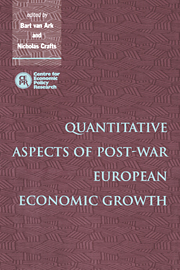Book contents
- Frontmatter
- Contents
- List of figures
- List of tables
- List of contributors
- Preface
- 1 Catch-up, convergence and the sources of post-war European growth: introduction and overview
- 2 Macroeconomic accounts for European countries
- 3 Sectoral growth accounting and structural change in post-war Europe
- 4 Measures of fixed capital stocks in the post-war period: a five-country study
- 5 Technology indicators and economic growth in the European area: some empirical evidence
- 6 Human capital and productivity in manufacturing during the twentieth century: Britain, Germany and the United States
- 7 Convergence and divergence in the European periphery: productivity in Eastern and Southern Europe in retrospect
- 8 Convergence: what the historical record shows
- 9 Growth and convergence in OECD countries: a closer look
- 10 On the historical continuity of the process of economic growth
- 11 Europe's Golden Age: an econometric investigation of changing trend rates of growth
- Index
5 - Technology indicators and economic growth in the European area: some empirical evidence
Published online by Cambridge University Press: 23 December 2009
- Frontmatter
- Contents
- List of figures
- List of tables
- List of contributors
- Preface
- 1 Catch-up, convergence and the sources of post-war European growth: introduction and overview
- 2 Macroeconomic accounts for European countries
- 3 Sectoral growth accounting and structural change in post-war Europe
- 4 Measures of fixed capital stocks in the post-war period: a five-country study
- 5 Technology indicators and economic growth in the European area: some empirical evidence
- 6 Human capital and productivity in manufacturing during the twentieth century: Britain, Germany and the United States
- 7 Convergence and divergence in the European periphery: productivity in Eastern and Southern Europe in retrospect
- 8 Convergence: what the historical record shows
- 9 Growth and convergence in OECD countries: a closer look
- 10 On the historical continuity of the process of economic growth
- 11 Europe's Golden Age: an econometric investigation of changing trend rates of growth
- Index
Summary
Introduction
Technological change is obviously a main factor behind growth in modern capitalist economies. As such, it is subject to much debate, both in the academic and the policy context. In the academic environment, the event of new growth theory (for example, Romer (1986) and Grossman and Helpman (1991); for an overview see Verspagen (1991b)) has put the issue of endogenous technological change back into the centre of attention. Policy debates around technological and economic competitiveness in the European Community are now more relevant than ever, with ‘traditional’ forms of integration (like the ERM) finding less and less support.
The impact of technological progress on economic activity is manifold. New technologies create and destroy jobs, have an impact on the quality of work, cause structural change, have an influence on specialization and trade-patterns, provide ‘windows’ of opportunity for backward nations, or, on the other hand, tend to push them further into (relative) poverty. Key to most of the discussions around the influence of technological innovation, however, are the opportunities it provides for long-term growth. The topic of sustainability of long-run growth is also crucially related to technological change.
The exact relation between technological change and economic growth, however, is hard to grasp with the current theoretical and empirical tools, and the data available for analysis. This chapter, nevertheless, focuses exactly on this question. The aim is to analyse the impact of technological change on long-run growth, by means of statistical analysis of the time series and cross-country data. Of course, a statistical analysis is limited by its very nature, and therefore many (crucial) aspects of the relation under investigation will not be covered.
- Type
- Chapter
- Information
- Quantitative Aspects of Post-War European Economic Growth , pp. 215 - 243Publisher: Cambridge University PressPrint publication year: 1997
- 32
- Cited by



